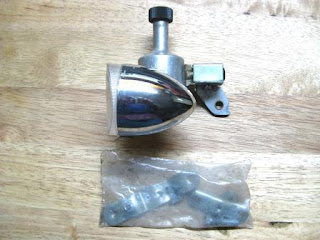I confess: I bought it because I had one like it in my youth. And the price was right.
It's a German-made Union "bloc" generator, on which the headlight is attached. Generators of this type are made to mount on the front fork. This one was most likely made during the mid-1970's. I tested it, and found its light output to be surprisingly good, given the light's small size and old-style bulb.
The best-known generator of this style was made by Soubitez of France. It--especially in its later iterations--was very stylish, as Soubitez products tended to be, and lighter in weight than other generators.
However, the light on this one is larger than the one on its Soubitez counterpart. It is also, as you can see, mounted on the side of the generator, while Soubitez's light was mounted on the front of the generator body. (Sanyo and other companies emulated Soubitez in this detail.)
Some would argue that the Union was a somewhat more efficient generator. Having owned both, as well as other generator sets made by both companies, I would say they were about equal in that regard.
French constructeurs commonly installed Soubitez generators (on brazed-on brackets) and lights on their touring bikes and randonneuses, while many Dutch and German city bikes were equipped with Union products.
I was going to use the Union bloc generator in the photo on Marianela. However, the strut from the basket got in the way.
That's too bad, because I think it would have looked right on the bike. And it's a good generator. The light is good, too, especially considering that it's an older technology. Perhaps there's a halogen or LED bulb that would fit.
Some would say that would violate the "spirit" of having a light like this. But I'm all for new technology (when it works better than the old) with old style. And, for me, that would have been the point of using it.

















